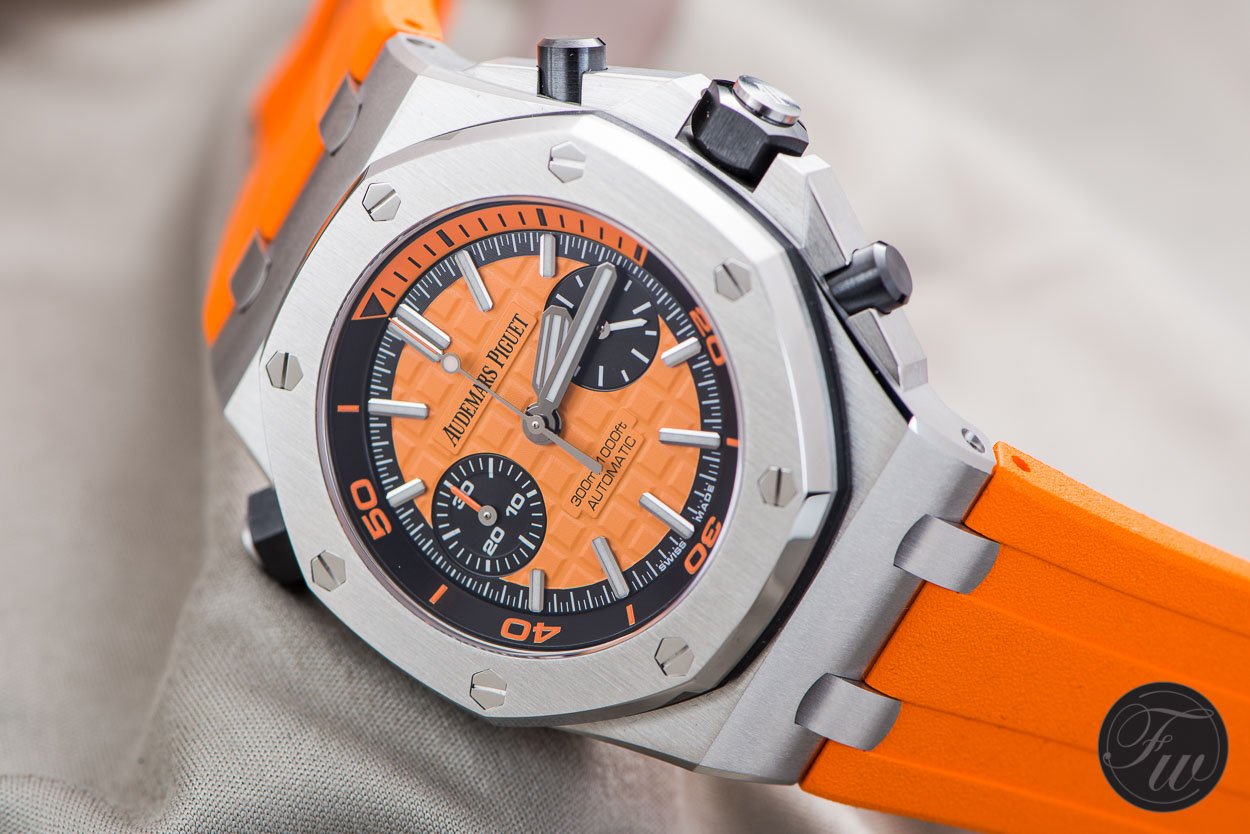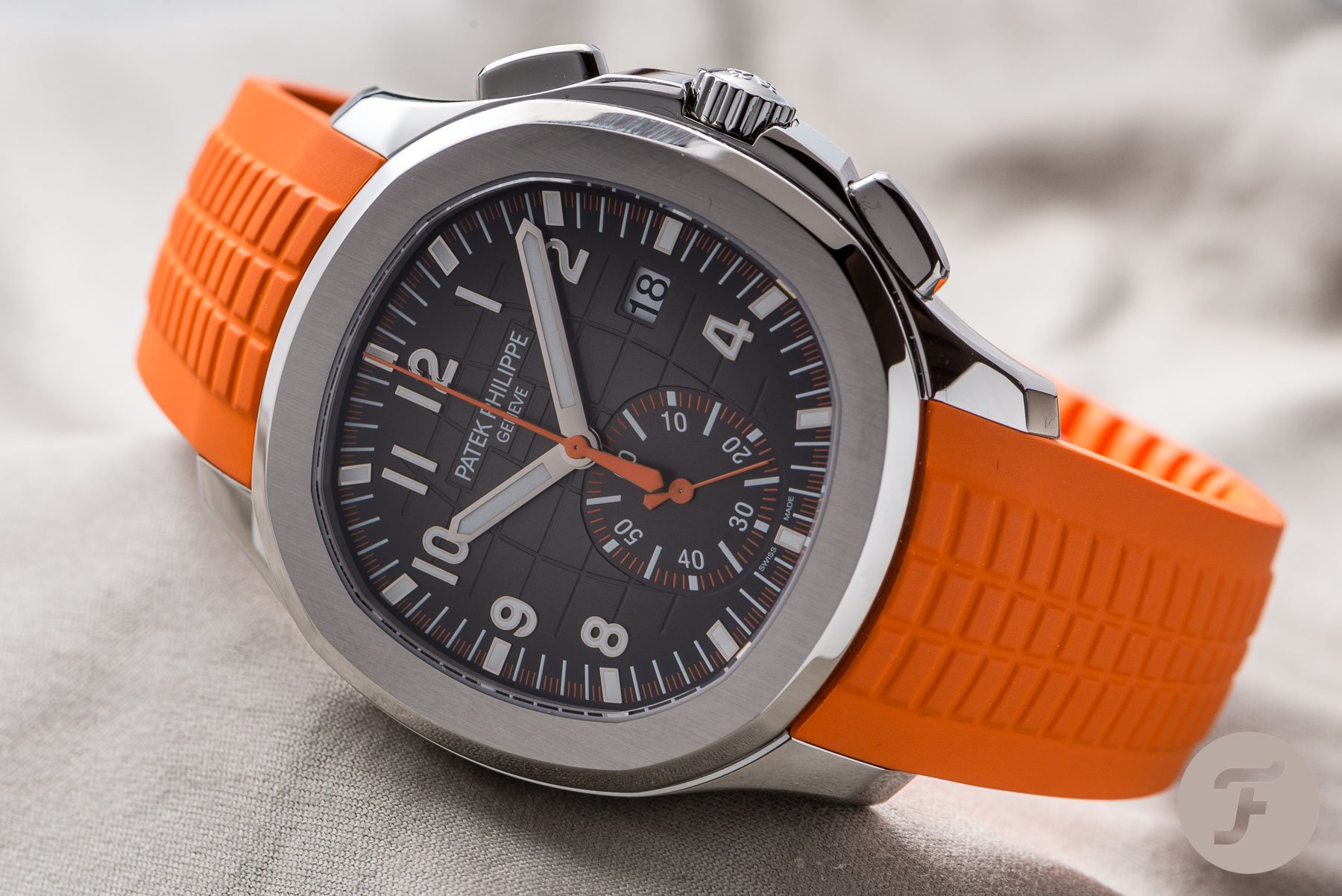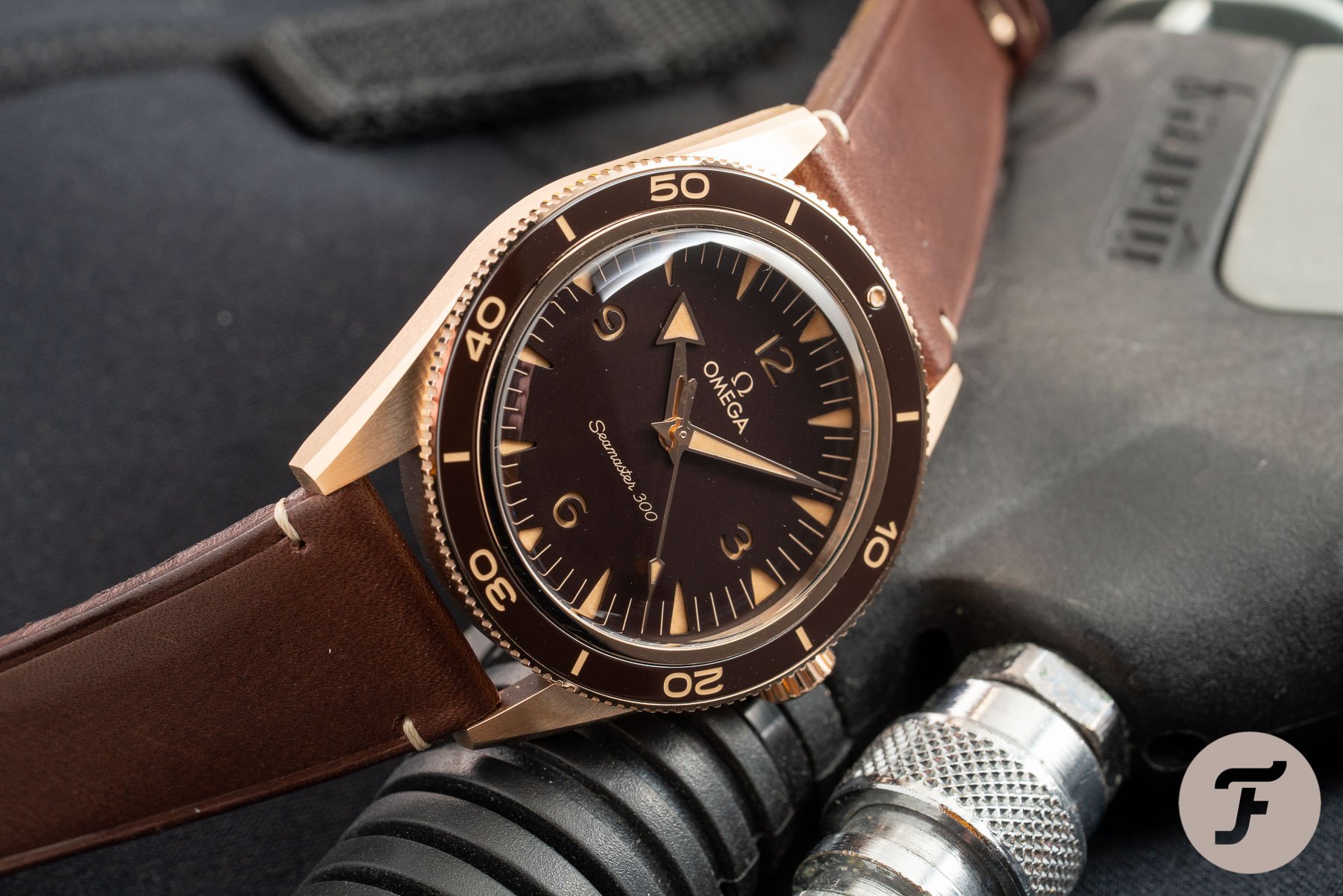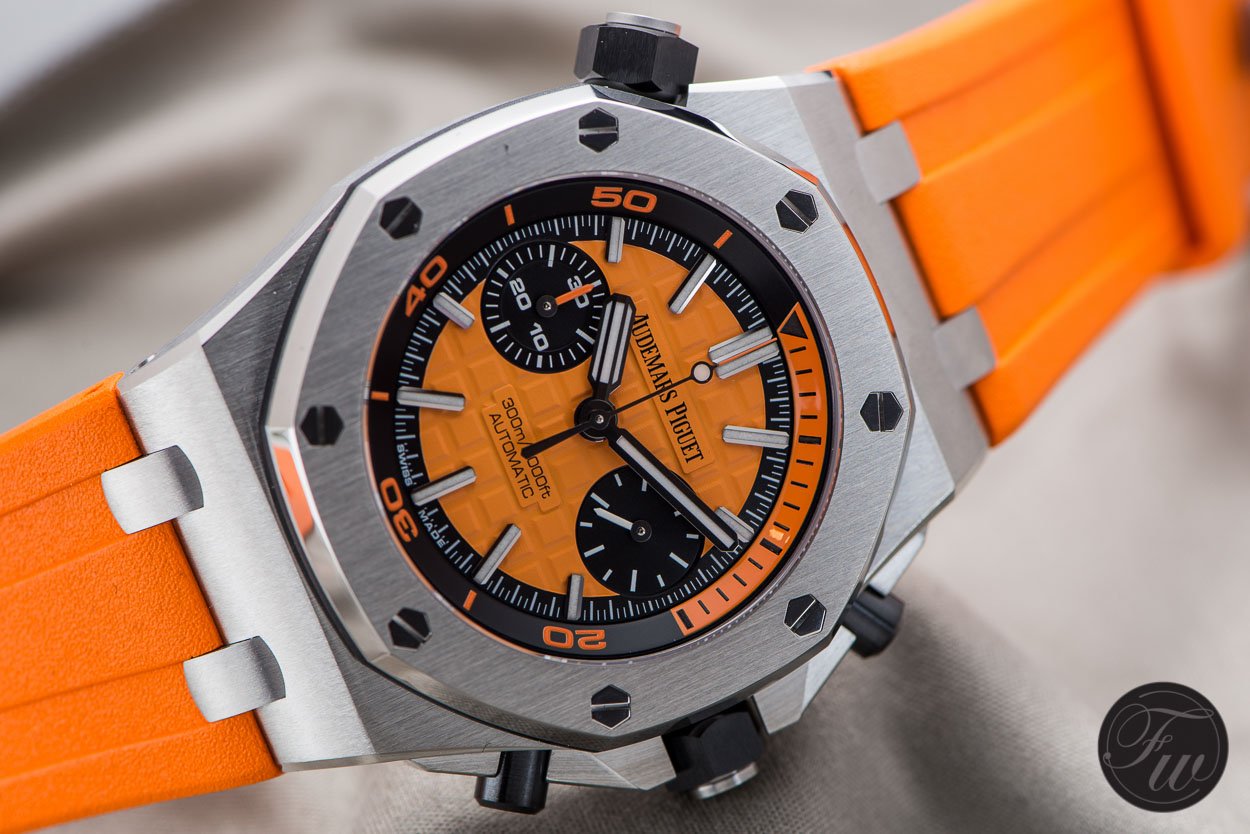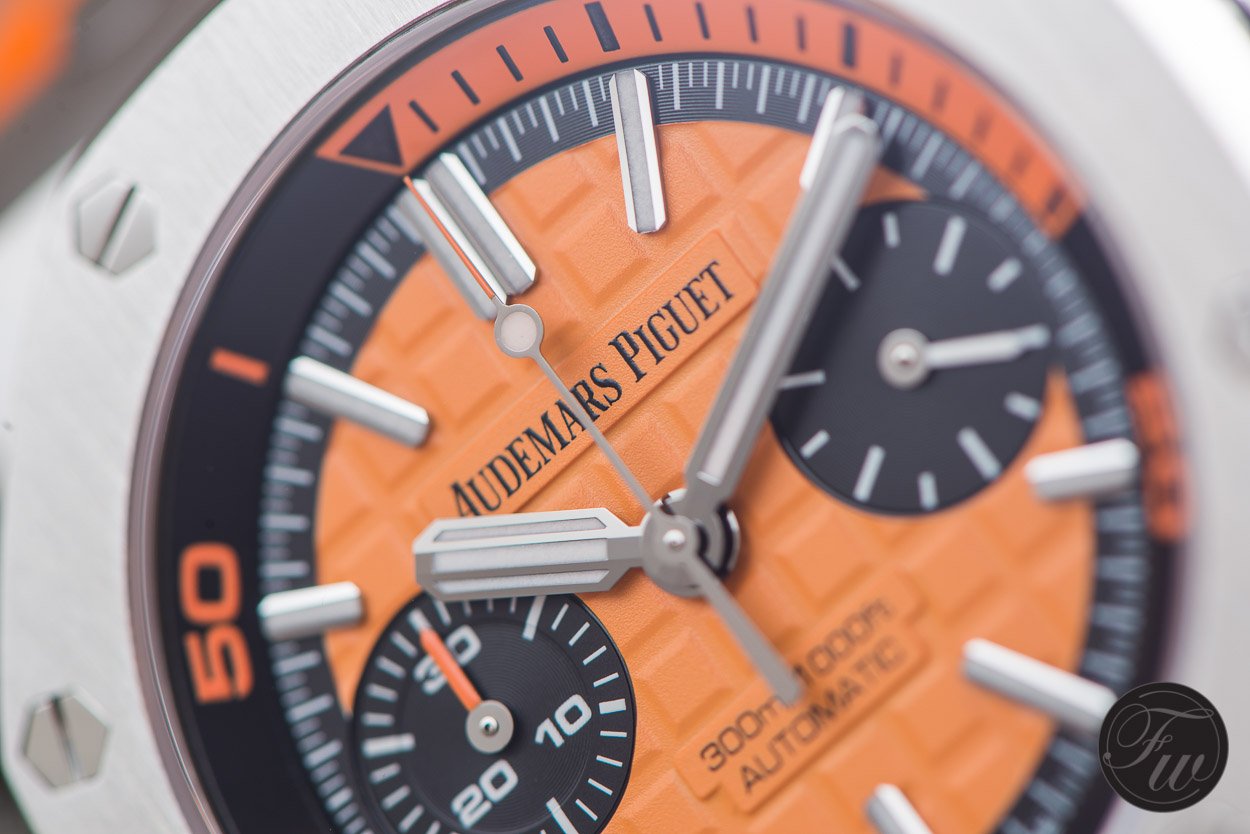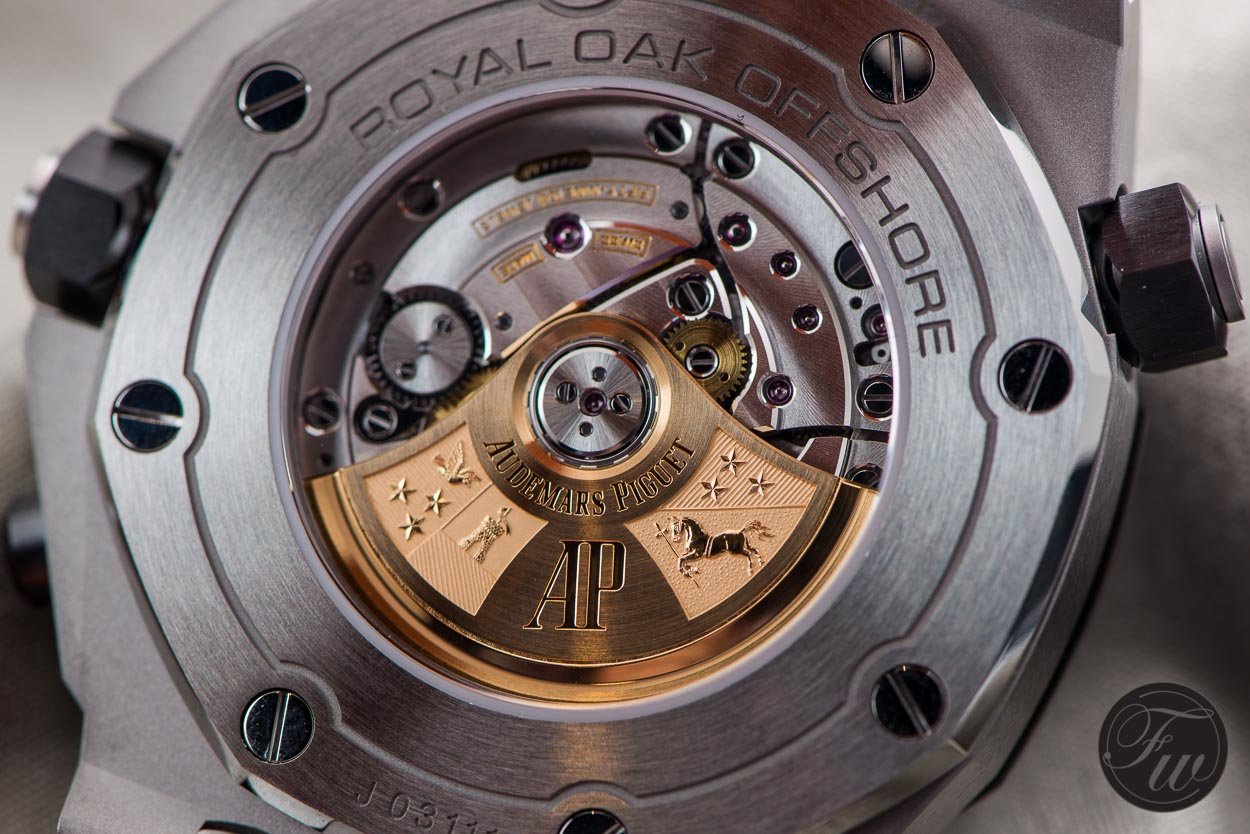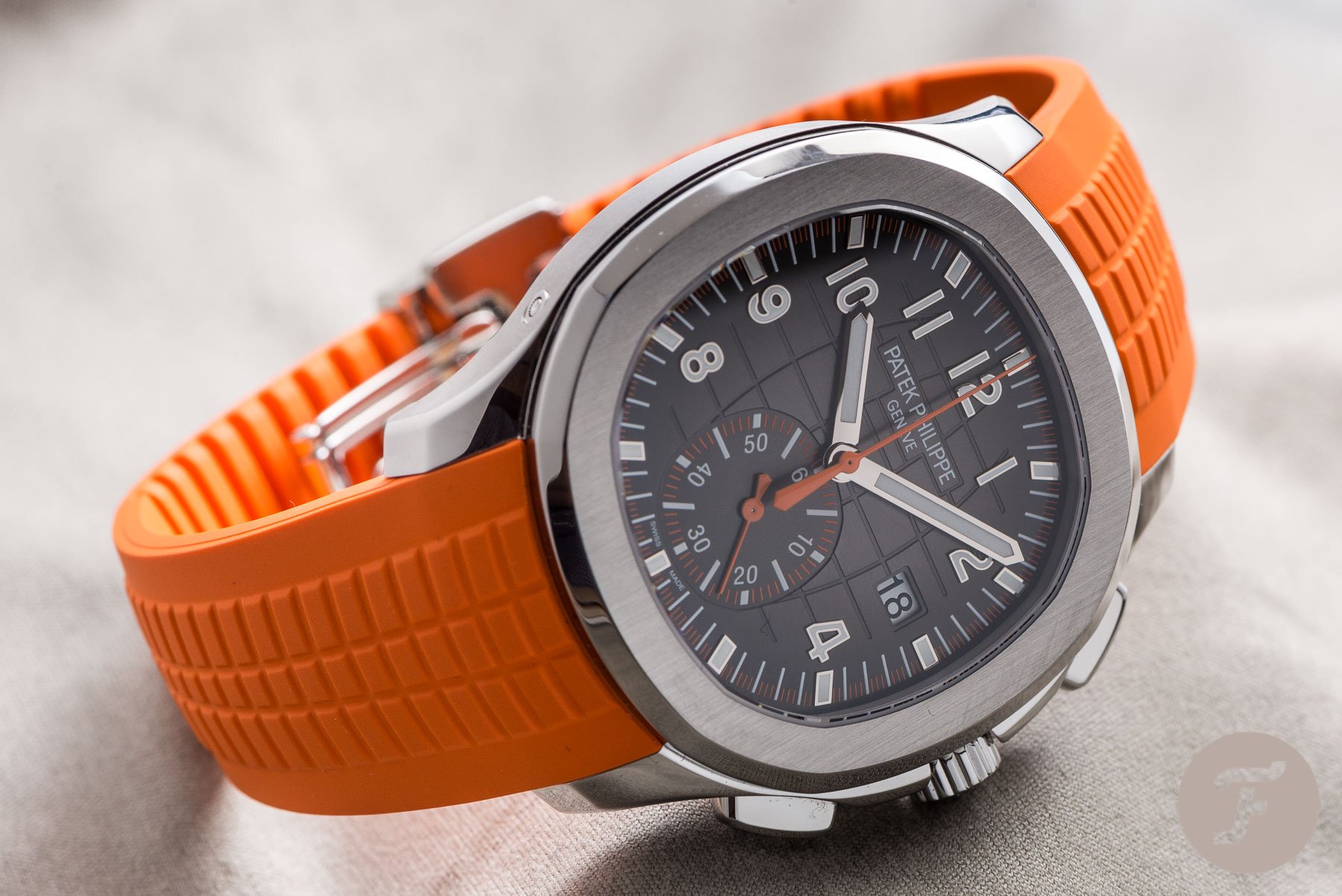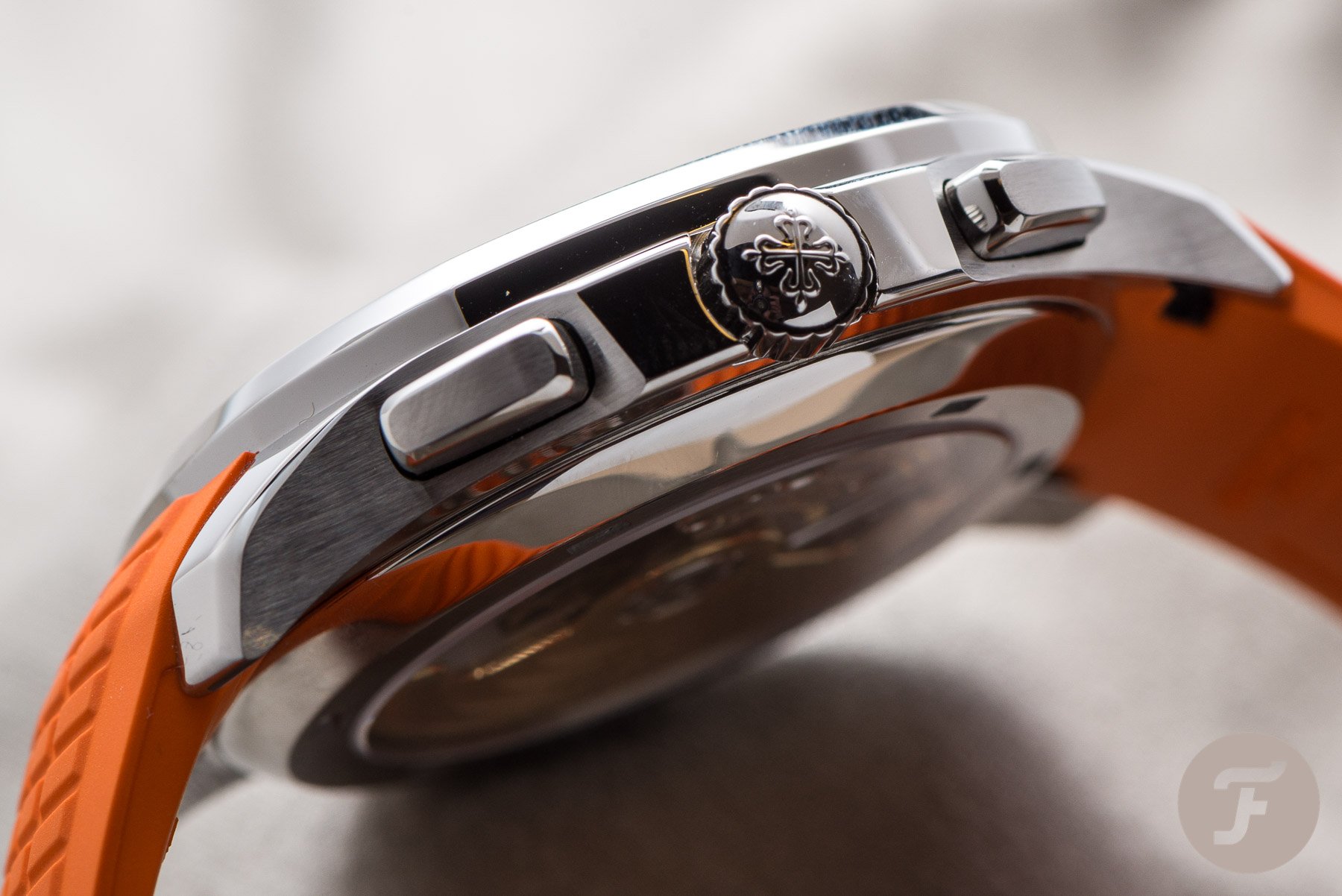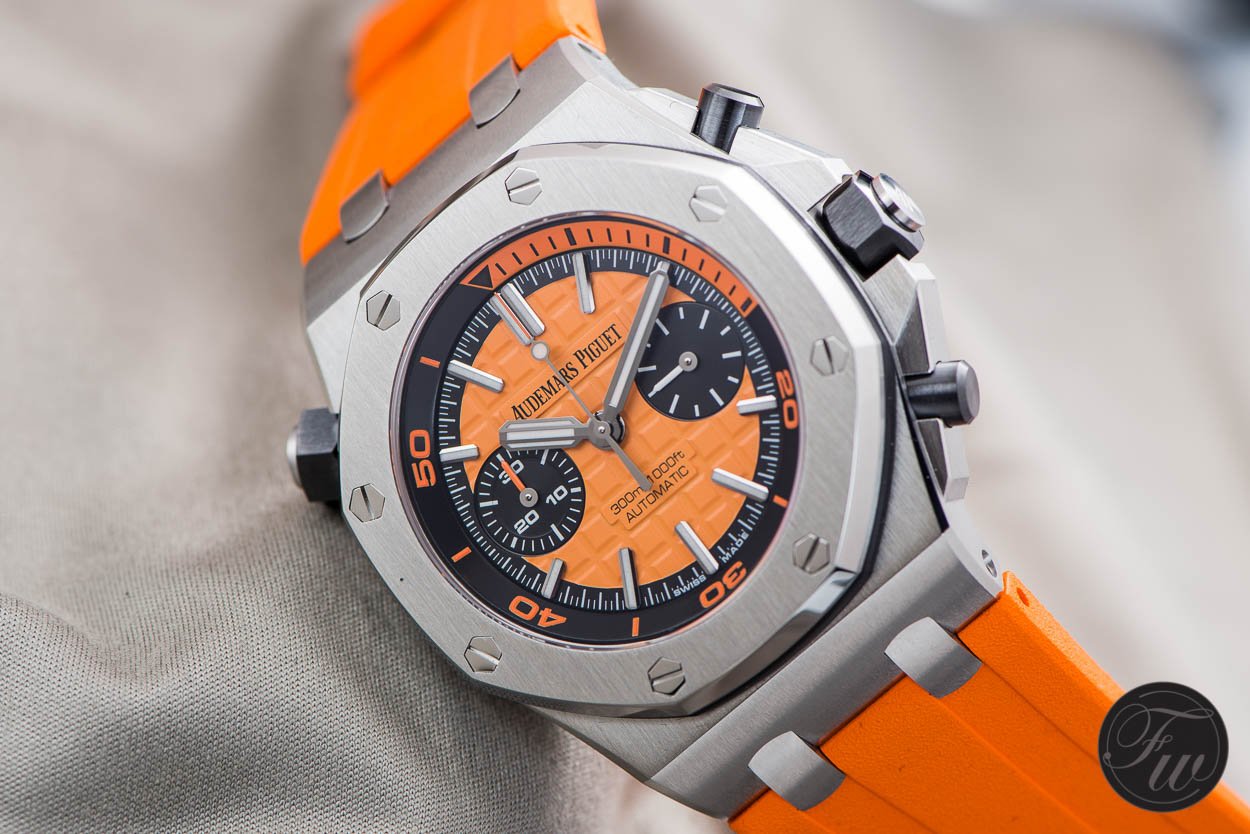Patek Philippe Aquanaut Vs. Audemars Piguet Offshore: The Orange Olympics
In our Sunday Morning Showdown, two of our writers go head-to-head in an epic showdown for the ages. Strong opinions and hysterical hyperbole are welcome (so feel free to join in with the fun in the comments section below). And don’t forget to let us know which watches you’d like to see torn to shreds/effusively exalted next week. We’ll try and feature as many of our readers’ choices as we can. With summer on the way, we get into the spirit by pitting two aquatic luxury sports chronographs against one another. The Patek Philippe Aquanaut Chronograph 5968A takes on the Audemars Piguet Royal Oak Offshore Diver Chronograph 26703ST.
Today’s Sunday Morning Showdown is all about two classical brands shunning any semblance of sophistication. Audemars Piguet and Patek Philippe share a traditional heritage, but today’s watches shed civility in place of pure extravagance. In the arena, we have two bright orange chronographs with aquatic abilities. With summer around the corner and the prospect of enjoying some downtime beyond our country’s respective borders, these watches fit the bill for the beach.
Nineties design classics
The roots of today’s contenders can be traced back to the ’90s. Both are the result of Audemars Piguet and Patek Philippe exploring new territory. The Audemars Piguet Royal Oak Offshore Diver Chronograph 26703ST is a descendant of the first Royal Oak Offshore 25721ST, appropriately nicknamed “The Beast.” First released in 1993, the Offshore was intended as the muscular version of the ’70s Royal Oak. Around the time of introduction, Emmanuel Gueit’s new design initially had a mixed reaction. Over time, the negativity dissipated, and the Offshore became the success story we all know. The first Royal Oak Offshore reference 25721ST even became an icon in its own right.
In 2010, Audemars Piguet broadened the range with the Royal Oak Offshore Diver. It maintains the bulky look but removes the chronograph module for a slimmer profile. AP even experiments with rubber strap combos and a signature crown at 10 o’clock to rotate the internal diving bezel. In 2016, the Offshore Diver collection reintroduced the chronograph module in a rainbow assortment of colors with a twin-register layout and no date. The resulting watch was a splash of summer for the wrist while still being a luxury statement.
The Aquanaut, the late bloomer
Like the original Nautilus, the Aquanaut is a bold step for Patek. Yet, it retains the more rounded lines of a classic Calatrava case than the brutalist edges of the Royal Oak. The Patek Philippe Aquanaut also created quite a buzz at Baselworld in 1997. The rubber strap×luxury watch craze was in its infancy, but Patek getting in on the action was still a surprise. For a brand where precious-metal dress watches are entry-level, undercutting the Calatrava with an even more approachable stainless steel sports watch on a rubber strap was a curveball. With a case that seemingly cherry-picked its design from Genta’s Nautilus and a purpose that was hard to pinpoint, the Aquanaut wasn’t exactly an instant hit.
Almost 25-years later, the Aquanaut is more popular than ever. Yet, despite the popularity, the collection only has ten model variants compared to thirty versions of the Nautilus. The standard 40.8mm model is available in steel and rose gold, with a wider 42.2mm model version in white gold with green and blue dials. In 2011 Patek added the much-praised Travel Time complication to the Aquanaut. But it was the Chronograph in 2018 where the Aquanaut came to the forefront of Patek’s collector base. The bright orange rubber strap ruffled feathers, but with the matching orange accents and functional dial, the Aquanaut Chrono became an overnight success. Both today’s options are uncanny in their approaches, but which is best? You decide!
Dive watches with a hint of gold
While Ben and Jorg are sharpening their claws, first up is a look back at the last showdown. The goal was to settle the Swatch group score between the bicolor Glashütte Original SeaQ Panorama Date and the Omega Seamaster 300 Bronze Gold. As it turns out, Jorg makes it three-in-a-row with the unique combination of bronze and gold of the Seamaster 300 at 65%. While the SeaQ had charm, a brilliant movement, and a level of finishing not seen in watches of this nature, it wasn’t enough to dispel the allure and curiosity of the Seamaster 300. With this week being on more equal grounds, let’s see if Ben can fight back to impede Jorg’s tirade in the battle of the luxury sports chronographs…in orange.
Ben — Audemars Piguet Royal Oak Offshore Diver Chronograph 26703ST
Jorg, I’m feeling the pain of loss over these past few weeks. But if I’m frank, the Seamaster 300 Bronze Gold deserved the win. Trying it on and seeing it in the metal convinced me this was something special from Omega. No doubt we’ll see this alloy spread to the rest of the Seamaster collection, maybe even on the Diver 300M. But today takes things up another notch. While neither choice is a dive watch in the traditional sense, I get the feeling that my Royal Oak Offshore Diver at least has the credibility of 300-meters water resistance versus 120-meters with the Patek. Last time had me fighting a war inside my head with Seamaster 300 opposition. But this time, the Aquanaut Chrono has design choices that irk me, making it easy to go for the jugular today.
But before I go in hot, it’s worth breaking down why the AP Offshore Diver is the timepiece you need to vote for. Like Jorg, I also favor the purity of a core design that stays close to the original vision. While I wasn’t a naysayer of the Offshore as Jorg was with the Aquanaut, the 15202 was still king of the Royal Oak collection. The Diver, however, redefined what the Royal Oak could be as a genuine tool watch. There may have been the military dial before it, but I was never a big fan of reference 14790ST’s entire numeral layout. The Diver keeps things close to the Genta sketch…but on steroids.
Mega mode activated
Core to the bulky visage of the Offshore Diver is the Méga Tapisserie texture on the watch face. The tapisserie pattern is standard on the Royal Oak. AP achieve this engraving with a nineteenth-century burin and pantograph gizmo at its dial facility. The “Méga” name comes from the enlarged size of the individual trapezoids on the Offshore range compared to the petite shapes on the 15202. The hands are also wider yet retain the “hot dog on sticks” motif. All these individual elements work harmoniously on the AP Diver to increase the impact without losing inspiration.
With the announcement of the Royal Oak Diver Chronograph in 2016, AP made it loud and clear that these new watches were here to make a statement. Rather than monochromatic color schemes, AP gave us a fruit salad of colors. While many were turned away, I was one of the few whose initial reaction was genuine joy. At the time, I had the IWC Aquatimer Cousteau Divers watch and was fascinated with bright orange and blue dials. The lime green and lemon yellow may have resembled highlighter pens, but the orange in combo with the black sub-dials was a home run.
No cyclops to take down a titan
Eschewing the date window with the Dubois-Depraz chronograph movement was a great choice too. I was never a fan of the deep-set date window on the Offshore due to the modular construction of caliber 3126 / 3840. It needed a magnifier just to be seen with the naked eye, and even then, it was still distorted. The Diver Chronograph avoids that nonsense with simple twin-register sub-dials that align with the central pinion. Despite the increased depth rating, the sapphire case-back exhibits the mechanism with the solid 22k gold rotor featuring the coat of arms of both the Audemars and Piguet families.
While a rotatable octagonal dive bezel would’ve been a fun inclusion, the Offshore elects for an internal rotating scale. The crown at the 10 o’clock position that cuts into the integrated lug is not a manual helium release valve seen on an Omega Planet Ocean. Instead, unscrewing this crown and turning it clockwise shifts the internal scale in an anti-clockwise direction to the desired minute. Affixing to the case is one of the standout rubber straps in the luxury watch game. The natural vulcanized rubber is exceptionally supple and well-made — it even adopts a grainy texture that is satisfyingly tactile. With a thickness of 14.75mm, it’s not as everyday wearable as Jorg’s Patek, but it undercuts the pricing by a whopping $15,874. The AP Royal Oak Offshore Diver Chronograph is $27,900 against Patek’s ludicrous $43,774 price tag.
Jorg, I am close to taking a bite out of this orange Offshore, so feel free to take the reigns with your overpriced novelty Patek.
Jorg — Patek Philippe Aquanaut Chronograph 5968A
Well, I’m going to be upfront with you, Ben. I was not a fan of the regular Aquanaut. From the moment I saw an Aquanaut reference 5066A in the early 2000s, I knew the collection was not for me. The sharp lines were softened to the point of lacking cohesiveness. The dial also resembled a block of chocolate and seemed too superficial for a brand like Patek Philippe. By placing too much focus on making an impact, the Aquanaut almost seemed like a “try-hard” and an “also-ran” in the wave of bold watches of the 2000s. Whereas the Nautilus exudes its era with class, the Aquanaut was a watch out of time and place.
2007 saw the introduction of the current 5167A that blew up the size from 36mm of the 5066A to 40.8mm. In tandem was some much-needed refinement to the chocolate block dial. The 5167A’s hand grenade pattern proved to be the winning canvas for the Aquanaut ever since.
Ben: I always got a comic book strip vibe from the Aquanaut dial. And now all I can imagine is what if a brand like Patek Philippe or Audemars Piguet put a comic book character on the dial of a wa…oh, wait!
Breaking the mold
I vividly recall when Patek Philippe introduced the Aquanaut Chronograph at Baselworld 2018. A lot of the discussion was placed on the orange rubber strap. Seriously, how can a strip of orange rubber cause such furor? It may have been out of character, and I typically prefer black on everything, but the orange strap added that element of spice missing in the Aquanaut. Suddenly, the Aquanaut came into focus for many buyers and became a hot watch. The demand of the chronograph promulgated through to the rest of the range too. While the Aquanaut Chronograph also looks great on the black strap, in cahoots with the dial accents, the orange option brings freshness.
The Aquanaut Chronograph has a more significant 42.2mm stainless steel case over the 40.8mm of the 5167A. Most noticeably, the chronograph pushers beef up the right case flank for that asymmetric style. Even with the addition of a complication, the dial has room to breathe. Instead of the obvious compur or compax layout, Patek elected to integrate the 60-minute chronograph counter without sacrificing the hour and minute track. The orange chronograph hands and markings offset the brown/gray dégradé dial. Combine this with a sub-dial that shares the case shape’s outline, and you have a perfectly adaptable luxury watch.
Ben: Except for the fact you no longer have a running seconds hand on a sports watch.
That Patek brilliance shines through
The Aquanaut Chronograph is powered by the Patek Philippe caliber CH 28-520 C. It’s the same movement that Patek Philippe uses for the Nautilus Chronograph reference 5980. It is a stunning movement to see in action through the sapphire case-back. The movement consists of 308 parts, operates at 28.800vph, and has a power reserve of at least 45-hours. It uses the latest Patek Philippe technology for its balance spring (Spiromax) and has a Gyromax balance (using c-shaped weights on the balance wheel rim for fine adjustment). The movement makes sure the profile of the Aquanaut Chronograph is substantial for Patek standards but still slim at 11.9mm, which is about the same as a Rolex Daytona.
As always with Patek, the finish is impeccable. Both the movement and the case refinements are up to the highest standard in the industry. Each time, I am stunned by the level of detail Patek incorporates into its timepieces. I am usually stubborn with my first impressions, but the Patek Philippe Aquanaut Chronograph won me over. Just by adding subtle elements that represent a significant change, so too is my opinion on the Aquanaut collection. It’s proof of the brilliance of Patek Philippe and why I would not hesitate to pay the $43,774 list price if there was the slightest possibility.
- Audemars Piguet Royal Oak Offshore Diver
- Patek Philippe Aquanaut Chronograph
A devastating combo
Ben: Now comes my time to lay into the Aquanaut Chronograph. Unlike Jorg, I appreciate the standard Aquanaut. I like the thinness, the patterns, and it is less pretentious than the Nautilus. But the Chronograph misses the mark. Most namely is the placement of the pushers on the crown side. Yes, this configuration is typical of most chronographs. But on the Aquanaut, you have a crown guard that evokes the ear shape of the Nautilus. Unlike the Nautilus, the time-only Aquanaut only has a single ear on the crown side. Placing these pushers on either side of the crown guard gives it an off-balance silhouette. For me, the better solution would be to put the chronograph pushers on the opposite side to equalize the shape. And it’s not like it would be out of the question, as the Aquanaut Travel Time managed to achieve this with functional hour adjuster pushers in a balanced case design.
Jorg: Implementing the pushers on the other side would instantly kill the functionality of a sports chronograph.
Ben: The other thing that drives me wild is the white date disc beneath the Aquanaut’s dial. Usually, I am not as bothered about this as some people. But on a $43,774 watch, Patek Philippe couldn’t have implemented a matching wheel for the admittedly glorious gray dial?
Jorg: Black on white is the most legible option. And even if they matched the color, the window casts a shadow over the disc, so the color would never look the same as the dial surface.
Knockout punch
Jorg: For a long time, I thought the Royal Oak Offshore was an unnecessary over-the-top statement. It felt too in your face and lacked the refinement that made the Royal Oak so brilliant. But I grew to appreciate the inaugural Royal Oak Offshore and the re-edition. But now, current offerings are too brash and unbalanced for me to get on board with.
Ben: I won’t defend all the choices in the Offshore range, but the Diver was always the option that went against the loud and proud direction. Yes, the colors are bright, but the dial is sleek with stylish ceramic pushers.
Jorg: To me, your Royal Oak Offshore Diver Chronograph is among the loud and proud, as you say. If you are into that, more power to you. To me, the Patek Philippe Aquanaut Chronograph finds that sweet spot between casual and high-end sophistication. Both Patek onlookers and seasoned collectors can appreciate the 5968A. That is why I choose the Aquanaut Chronograph.
But what do our readers think? Vote now and let us know why you made your choice in the comments below.

